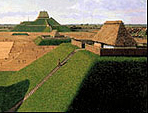| 
P ublic works ritually renewed to preserve civic order
Perhaps human sacrifice was also part of a system of social control
of the labor force. The archaeological evidence clearly demonstrates
that the mounds were built in stages and, like the plazas, palisades,
woodhenges, and other public works at Cahokia, had to be regularly
repaired and reconstructed. Although wood is a durable material
if it is constantly wet or constantly dry, wood in damp earth
is subject to the wet/dry conditions that promote rapid rot. Urban
renewal was necessary almost continuously in Cahokia, and sometimes
groups of buildings and even whole neighborhoods were swept away
so as to reorder the earthly cosmos or clear land for new or rebuilt
structures. Only strong social control and political power can
make possible such large-scale changes in the civic fabric. In
addition, public works of such magnitude required mobilizing and
maintaining a large labor force.
The human cost of public works
Some useful numbers also help us grasp the enormous effort that
goes into making a structure the size of Monks Mound with human
labor. This pharaonic enterprise required carrying 14,666,666
baskets, each filled with 1.5 cubic feet of dirt, weighing about
fifty-five pounds each, for a total of 22 million cubic feet.
For comparison, an average pickup truck holds 96 cubic feet, so
it would take 229,166 pickup loads to bring the dirt to the site.
If thirty people each carried eight baskets of earth a day, the
job would take 167 years. Various scholars have calculated time
and labor estimates that differ widely, and we do know that the
mounds usually were built not all at once but in a series of stages,
sometimes over many years.
In addition to the four palisades, more than a hundred mounds,
and five woodhenges, there were many other public buildings--granaries,
the palace-temple of the chief, and the residences of other members
of the elite. Erecting a woodhenge was complicated; it involved
digging large bathtub-shaped foundation holes, aligning and measuring,
and coordinating the work of pulling the posts upright. Large
work crews were also assigned to level the plazas, filling in
the swales and tamping the surface smooth.
«
previous
7 of 8
next
»
|
 |

|
 |


Figure
#4: Cahokia Rendering (Lloyd K. Townsend) »
| M
O R E |
| Learn
more about Cahokia
in Bringing the Heavens to Earth. |
|
|
|